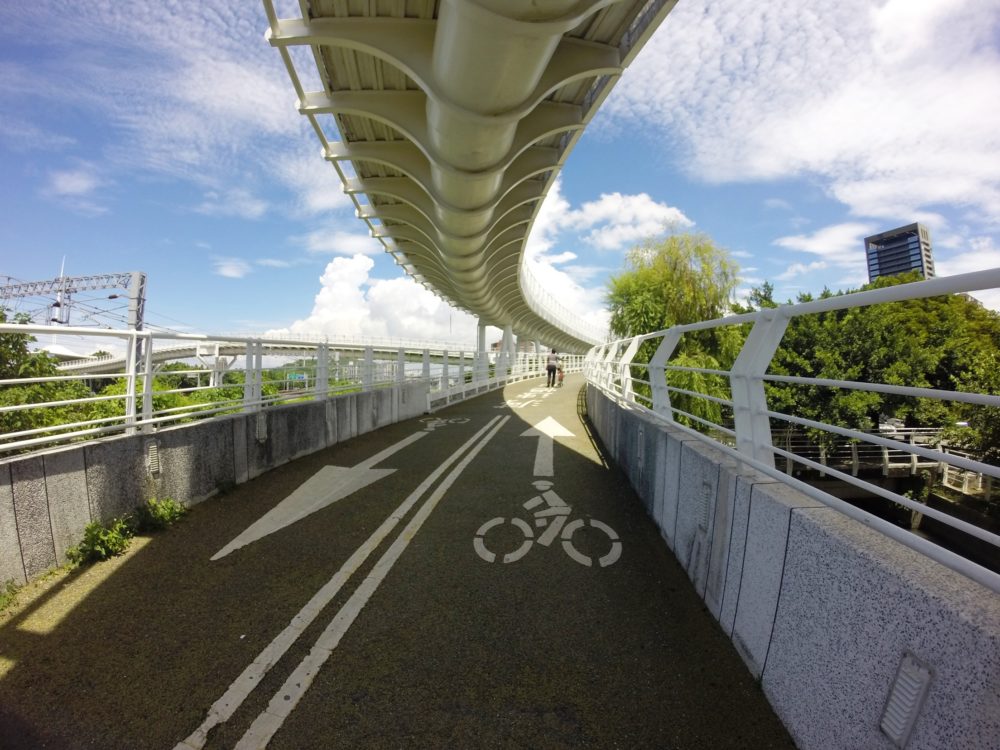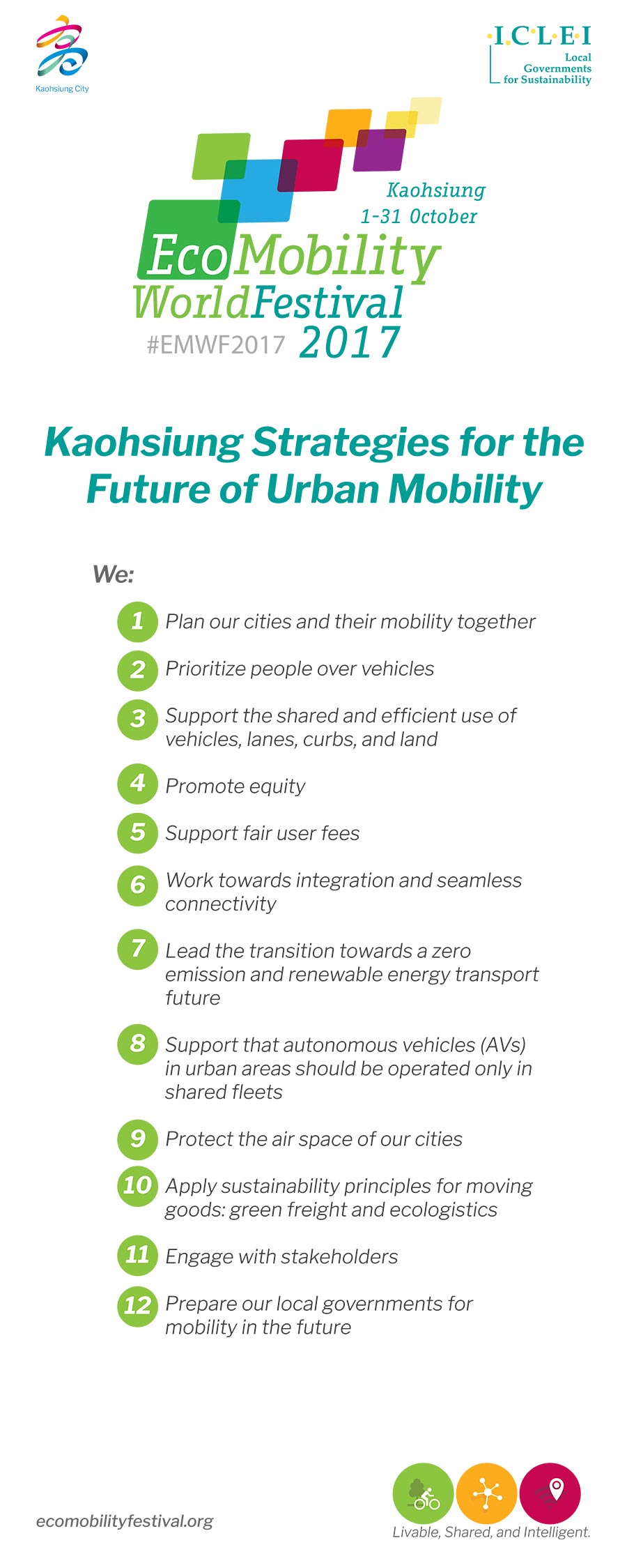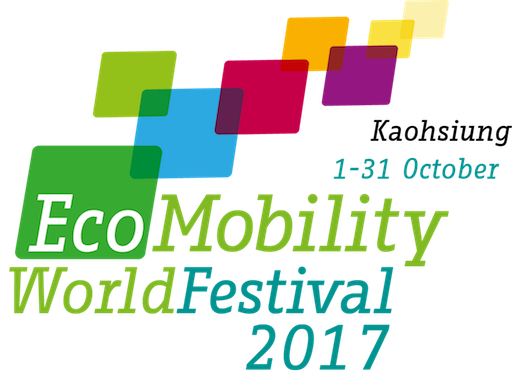The Kaohsiung Strategies for the Future of Urban Mobility
The Kaohsiung Strategies for the Future of Urban Mobility were adopted 4 October at the closing plenary of the EcoMobility World Congress 2017 in Kaohsiung.
Our cities are experiencing unprecedented changes in transportation that are driven by social, economic and technical trends. As city leaders, it is our responsibility to guide these changes to ensure that accessible, connected, affordable, safe, and environmentally friendly mobility options are being integrated into our existing and future communities.
The Kaohsiung Strategies for the Future of Urban Mobility are one of the legacies of the Kaohsiung EcoMobility World Festival and inspire local governments to transform their transportation systems and mobility patterns towards more sustainable, low-carbon and people-centered models that reduce automobile dependency.
The Kaohsiung Strategies, launched 4 October at the EcoMobility World Congress in Kaohsiung, were shared at the UN Climate Conference COP 23 in Bonn in November 2017, bringing a strong message on sustainable urban mobility to the international stage. They also serve as a call to action to apply the 2030 Sustainable Development Goals and the New Urban Agenda to local mobility policies.
The Kaohsiung Strategies are based on the Shared Mobility Principles for Livable Cities.
Our starting point:

Sustainable , inclusive, prosperous, and resilient cities depend on transportation that facilitates the safe, efficient and pollution-free flow of people and goods, while also providing affordable, healthy, and integrated mobility for all and accepting low-carbon and resource efficient development as key goals.
On the occasion of the EcoMobility World Festival 2013 and upon invitation of the Mayor of Suwon and ICLEI – Local Governments for Sustainability, mayors, city planners and mobility experts convened in Suwon, South Korea, in September 2013 for the second EcoMobility 2013 Congress. Among these were many representatives from the EcoMobility Alliance.
As an output of the congress and the festival the Suwon EcoMobility Impulse was introduced to the participants and the dignitaries. The purpose of the Suwon 2013 EcoMobility Impulse was to provide guiding thoughts, principles, examples and starting points for concrete improvements in urban planning & development, be it for existing municipalities or new towns, towards the greening of mobility in our cities worldwide.
The Johannesburg Declaration on Ecomobility in Cities
The Johannesburg Declaration on Ecomobility in Cities is one of the outcomes of the second EcoMobility World Festival 2015, which took place in Johannesburg, South Africa.It has been developed by ICLEI – Local Governments for Sustainability and the City of Johannesburg and has received valuable input from partners and experts, in particular from SLoCaT.
This Declaration was first endorsed by city leaders and experts who convened in Johannesburg, South Africa, in October 2015 for the EcoMobility Dialogues.
References:
- Alan C. McKinnon (2016): Freight Transport Deceleration: Its Possible Contribution to the Decarbonisation of Logistics, Transport Reviews, 36 (4): 418-436.
- Bloomberg-Aspen Initiative. 2017. Taming the Autonomous Vehicle: A Primer for Cities. www.bbhub.io/dotorg/sites/2/2017/05/TamingtheAutonomousVehicleSpreadsPDF.pdf
- BNEF and McKinsey. 2016. An integrated perspective on the future of mobility. https://www.mckinsey.com/business-functions/sustainability-and-resource-productivity/our-insights/an-integrated-perspective-on-the-future-of-mobility
- City of London, 2015
- European Transport Safety Council (ETSC). 2005. www.etsc.be
- Federal Aviation Administration, USA. 2016. FAA Aerospace Forecasts – Fiscal Years 2017 – 2037. www.faa.gov/data_research/aviation/aerospace_forecasts/media/FY2017-37_FAA_Aerospace_Forecast.pdf
- http://dx.doi.org/10.1787/9789282108000-en
- International Energy Agency. 2008. Energy Technology Perspectives 2008 – Scenarios and Strategies to 2050, OECD
- Internet of Things (IoT) Institute, Overland Park, Kansas, USA. 2017. www.ioti.com/security/8-drone-related-security-dangers
- OECD – International Transport Forum. 2015. Urban Mobility System Upgrade: How shared self-driving cars could change city traffic. Corporate Partnership Board Report, 1–36. https://doi.org/10.1007/s10273-016-2048-3
- OECD/ITF. 2017. ITF Transport Outlook 2017, OECD Publishing, Paris.
- UN. The Sustainable Development Goals (SDGs). 2015. www.un.org/sustainabledevelopment/sustainable-development-goals/
- UNEP. 2010. Share the Road: Investment in Walking and Cycling Road Infrastructure. https://www.fiafoundation.org/media/44430/share-the-road-report.pdf
- URBACT. 2017.Want to reduce traffic in cities? These parking policy tools will help. Tatjana Marn. http://www.blog.urbact.eu/2017/04/want-to-reduce-traffic-in-cities/
- World Bank. 2002. Cities on the Move: A World Bank Urban Transport Strategy Review. Washington, DC. © World Bank. https://openknowledge.worldbank.org/handle/10986/15232 License: CC BY 3.0 IGO.
- World Bank; Institute for Health Metrics and Evaluation. 2016. The Cost of Air Pollution: Strengthening the Economic Case for Action. World Bank, Washington, DC. © World Bank. https://openknowledge.worldbank.org/handle/10986/25013 License: CC BY 3.0 IGO.

